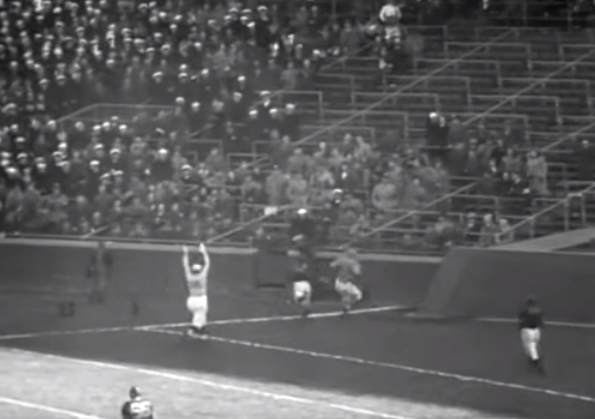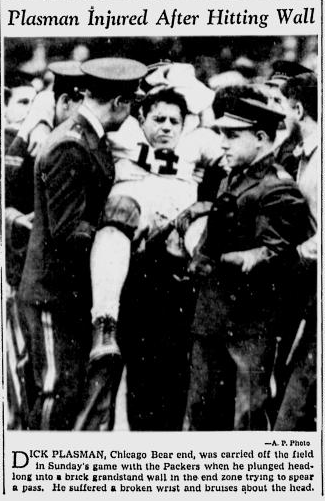Before there was The Frozen Tundra of Lambeau Field, there was “the frozen tundra” of Yankee Stadium . . . and “the frozen tundra at Wrigley Field.” Surprised? So was I.
When I started my research, I was merely trying to determine when people began referring to Lambeau as The Frozen Tundra. After all, the Cowboys are in Green Bay to reprise their Ice Bowl of 47 years ago, and I’d always heard the term had come from that famous frigid day.
Sure enough, a 2010 story in the Los Angeles Times reported: “It was coined by Steve Sabol, now president of NFL Films, and he used it in his script for the [highlight film of the] ‘Ice Bowl,’ the 1967 NFL championship game between the Packers and Dallas Cowboys.”
Sounds plausible enough. Steve was a much-underrated wordsmith (and as an added bonus, played football at the same school – Colorado College – as Lions great Dutch Clark).
There’s only one problem. In his column about the game, Arthur Daley of The New York Times typed these words:
Thus did the Packers win, 21-17, and whisk themselves from the frozen tundra of Green Bay to their destined date with the Oakland Raiders in the Super Bowl at more salubrious Miami a fortnight hence.
So maybe Sabol got the idea from reading Daley’s nationally syndicated column.
Except. After doing some more digging, I discovered the term was already in circulation. A few days before the game, Chuck Ward of the Wellsville Daily Reporter in New York wrote:
Somehow the game loses meaning when you talk about it being worth $30,000 or so to each and every player. But that’s about the amount of booty the Green Bay Packers and the Dallas Cowboys will be butting heads for Sunday afternoon on the frozen tundra of Green Bay’s Lambeau Field.
But Ward wasn’t the first, either. In 1965, in his follow-up to the Western Conference playoff between the Packers and Colts, Jerry Izenberg of the Newark Star-Ledger described the winning drive thusly:
So here was Green Bay, driving through the gloom of the frozen tundra toward the Baltimore goal. With second and 10 on the Baltimore 25, Elijah Pitts, replacing the wounded [Paul] Hornung, clawed forward for four yards, putting the ball squarely in front of the goal posts.
That’s the earliest instance I’ve found of Lambeau Field being called The Frozen Tundra — late December 1965, two years before the Ice Bowl. But there are iced-over fields, obviously, in places other than Green Bay. Which raised the question: Had any of them ever been referred to as “the frozen tundra”?
As it turns out, yeah. Here’s Jack Hand of The Associated Press advancing the 1963 title game (Giants vs. Bears):
It is reasonable to assume that there will be a little violence on the frozen tundra at Wrigley Field, just as there was last December when the Green Bay Packers and the Giants met in the Yankee Stadium ice box.
Finally — speaking, as Hand was, of that “Yankee Stadium ice box” — here’s Cameron Snyder of the Baltimore Sun covering the Giants-Packers championship game a year earlier:
It wasn’t a day fittin’ for offenses and both the Packers and Giants failed to demonstrate any consistency in their attacks. The wind gusts played havoc with the passes and the frozen tundra spilled ball carriers and tacklers indiscriminately.
I’m not suggesting my research in any way settles the issue. I’m just saying that, in a few short hours, I turned up Frozen Tundras going back to 1962, five years before Sabol supposedly “coined” it.
I even came across a “frozen tundras” in a 1931 story about an upcoming Army-Notre Dame game at Yankee Stadium. This is from the Brooklyn Eagle:
When Army and Notre Dame have weather, they have nothing else but. Remember the zero gale that swept the field two years ago when Jack Elder intercepted the pass to win for Notre Dame on a run of 98 yards, with two teams slipping and slithering over frozen tundras of the big Bronx ball park?
The Frozen Tundra of Wrigley Field. The Frozen Tundra of Yankee Stadium. I still like The Frozen Tundra of Lambeau Field the best. Especially when John Facenda, NFL Films’ Voice of God, says it.
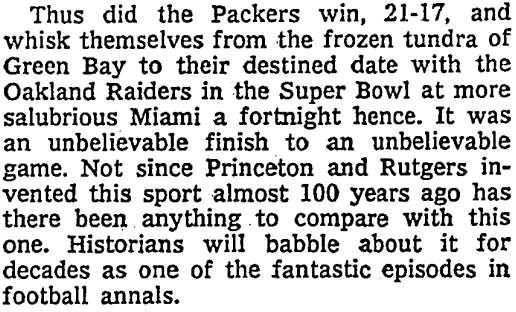
Arthur Daley in the Jan. 2, 1968, New York Times
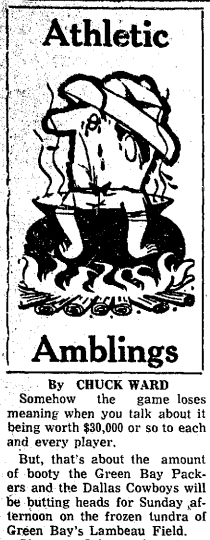
From the Dec. 27, 1967, Wellsville (N.Y.) Daily Reporter

Jerry Izenberg in the Dec. 29, 1965, Syracuse Post-Standard
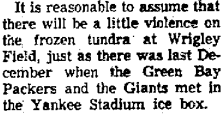
Jack Hand of The Associated Press, Dec. 24, 1963
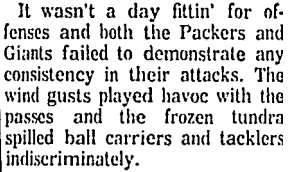
Cameron Snyder in the Dec. 31, 1962, Baltimore Sun

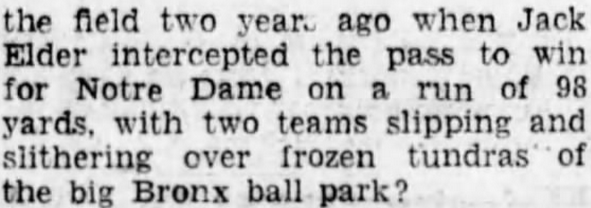
George Currie in the Nov. 28, 1931, Brooklyn Eagle
